Image: The forearm of a public health technician is seen covered with sterile female Aedes aegyti mosquitoes after leaving a recipient to cultivate larvae, in a research area to prevent the spread of Zika virus and other mosquito-borne diseases, at the entomology department of the Ministry of Public Health, in Guatemala City, January 26, 2016. REUTERS/Josue Decavele
By Julie Steenhuysen
CHICAGO (Reuters) – U.S. health officials are stepping up efforts to study the link between Zika virus infections and birth defects in infants amid predictions for widespread circulation of the mosquito-borne virus within the United States during warmer months.
The U.S. Director of the National Institutes of Health on Tuesday called for intensified efforts to study the impact of Zika infections, citing a recent study estimating the virus could reach regions where 60 percent of the U.S. population lives.
The mosquito-borne virus has been linked to brain damage in thousands of babies in Brazil. There is no vaccine or treatment for Zika, a close cousin of dengue and chikungunya, which causes mild fever and rash. An estimated 80 percent of people infected have no symptoms, making it difficult for pregnant women to know whether they have been infected.
On Monday, the World Health Organization predicted the virus would spread to all countries across the Americas except for Canada and Chile.
In a blog post, NIH Director Dr. Francis Collins cited a Lancet study published Jan. 14 in which researchers predicted the Zika virus could be spread in areas along the East and West Coasts of the United States and much of the Midwest during warmer months, where about 200 million people live.
The study also showed that another 22.7 million people live in humid parts of the country where mosquitoes carrying the virus could live year round.
Given the threat, Collins said “it is now critically important to confirm, through careful epidemiological and animal studies, whether or not a causal link exists between Zika virus infections in pregnant women and microcephaly in their newborn babies.” Microcephaly results in babies being born with abnormally small heads.
Experts say there is still much to learn about Zika infections. For example, it is not clear how common Zika infections are in pregnant women, or when during a pregnancy a woman is most at risk of transmitting the virus to her fetus.
Collins said the National Institute of Allergy and Infectious Disease is conducting studies to more fully understand the effects of Zika in humans, and to develop better diagnostic tests to quickly determine if someone has been infected. The NIAID is also working on testing new drugs that might be effective against the virus.
The blog post was followed by the announcement on Tuesday of new guidelines from the U.S. Centers for Disease Control and Prevention providing instructions for pediatricians treating infants whose mothers may have been exposed to the virus during pregnancy.
In those guidelines, the CDC makes clear that Zika virus is considered a nationally notifiable condition, and instructs doctors to contact their state or territorial health departments to facilitate testing of potentially infected infants.
The guidelines for the care of infants affected by Zika infections follows CDC guidelines for caring for pregnant women exposed to Zika virus, which were first reported by Reuters. The CDC said last week it is trying to determine how many pregnant women may have traveled to affected regions in the past several months.
(Reporting by Julie Steenhuysen; Editing by James Dalgleish)
Copyright 2015 Thomson Reuters. Click for Restrictions.


